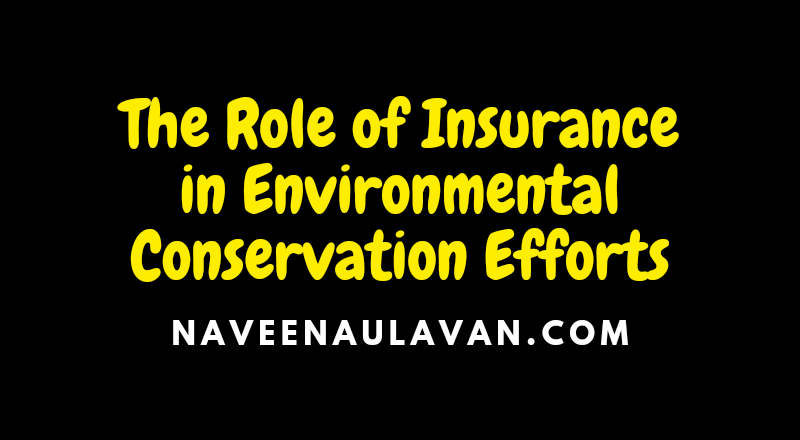Environmental conservation has become a global priority due to the increasing threats posed by climate change, deforestation, pollution, and other activities impacting the planet. While governments, NGOs, and individuals play crucial roles in conservation efforts, insurance has emerged as a valuable tool in mitigating environmental risks and encouraging sustainable practices. This article explores the role of insurance in environmental conservation, highlighting how it promotes risk management, encourages sustainable behavior, and provides financial support for restoration efforts.
1. Risk Management and Loss Prevention
1.1 Insuring Against Natural Disasters
One of the primary roles of insurance in environmental conservation is to provide protection against natural disasters. Insurance companies offer coverage for property damage caused by events such as hurricanes, floods, and wildfires. By transferring the financial burden to insurers, individuals and businesses are motivated to implement preventive measures and reduce their vulnerability to such disasters.
1.2 Encouraging Responsible Practices
Insurance policies often include clauses that reward policyholders who take steps to reduce their environmental impact. For example, a company that implements sustainable waste management practices or uses renewable energy sources may receive lower premiums or additional coverage benefits. This incentivizes businesses to adopt environmentally-friendly practices and contributes to overall conservation efforts.
1.3 Environmental Impact Assessments
Insurance companies play a significant role in risk assessment and management. They conduct comprehensive environmental impact assessments to evaluate the potential risks associated with specific projects or activities. By identifying and quantifying potential environmental risks, insurers can help businesses and organizations make informed decisions regarding the mitigation of these risks. This process ensures that environmental conservation is given due consideration in every decision-making process.
2. Conservation Financing and Restoration Efforts
2.1 Project and Ecosystem Restoration Insurance
Environmental insurance covers not only risks but also provides financial support for conservation and restoration efforts. Project-specific insurance policies exist to support the restoration of ecosystems, habitats, and biodiversity. These policies ensure that funds are available for initiatives such as reforestation, habitat restoration, and preservation of endangered species. By financially supporting restoration projects, insurance plays a vital role in reversing the damage caused by human activities.
2.2 Payment for Ecosystem Services (PES)
Payment for Ecosystem Services (PES) is an innovative approach where individuals or organizations receive financial incentives for conserving or restoring ecosystems. Insurance companies can help facilitate PES schemes by underwriting the risks associated with these programs. They provide coverage against potential losses or damages attributed to ecological restoration initiatives, enabling individuals and organizations to participate in these projects without bearing excessive financial risks.
2.3 Catastrophic Risk Pooling
Catastrophic risk pooling involves the pooling of risks across multiple insurance policies to create a financial safety net for large-scale environmental disasters. This approach ensures that insurance companies collectively absorb the losses associated with an event such as an oil spill, allowing for prompt response and improved restoration efforts. By spreading the risks, insurance companies ensure the availability of funds for necessary conservation and restoration actions, even in challenging circumstances.
3. Innovation and Adaptation
3.1 Insurtech and Environmental Conservation
The emergence of insurtech, the application of technology to the insurance industry, has presented new opportunities for environmental conservation. Insurtech companies leverage data analytics, remote sensing technologies, and artificial intelligence to assess and manage environmental risks more effectively. These advancements enable insurers to develop more comprehensive risk models and offer innovative insurance products that address the specific needs of environmental conservation efforts.
3.2 Parametric Insurance and Climate Change
Parametric insurance is an insurance product that pays out based on predefined triggers instead of traditional loss assessment methods. This type of insurance can be used to address risks associated with climate change, such as extreme weather events. By offering quick and predictable payouts based on specific climate indicators, parametric insurance helps expedite recovery efforts and supports climate resilience measures. This innovative insurance solution contributes to environmental conservation by encouraging proactive measures to mitigate and adapt to climate change.
Conclusion
Insurance plays a critical role in environmental conservation efforts by promoting risk management, encouraging responsible practices, and providing financial support for restoration initiatives. Through comprehensive risk assessments, insurers identify and quantify environmental risks, ensuring informed decision-making. Additionally, the financial incentives and coverage benefits offered by insurance companies encourage sustainable behavior and support conservation practices. Furthermore, insurance facilitates the availability of funds for restoration projects, fosters innovation through insurtech, and addresses climate change risks through parametric insurance. Together, these roles make insurance an indispensable tool in promoting and preserving environmental conservation efforts on a global scale.
